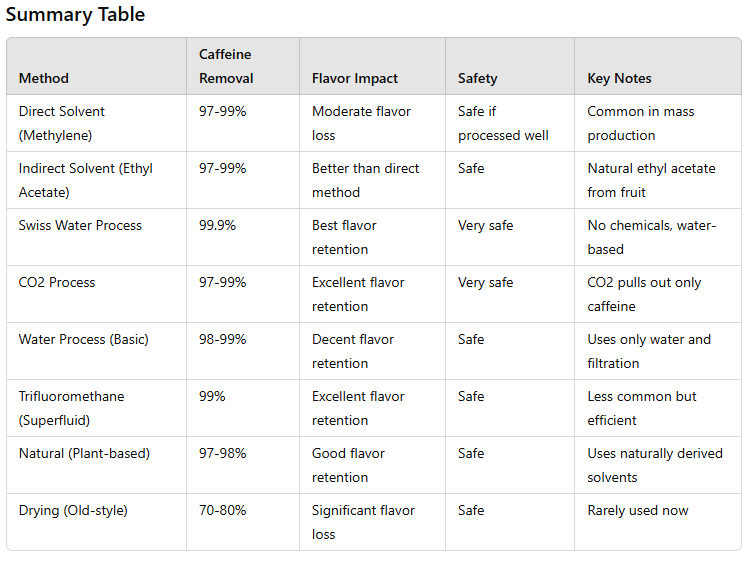How to Brew Decaf: It's Not Just a Five Letter Word
- Keith Lyons

- Feb 28
- 3 min read

When you process coffee beans to decaffeinate them, you inherently change the structure of the bean, and this impacts how it needs to be brewed. Decaf is more brittle, and the darker the roast they get even further brittle. This is taken into account for brew time, water temp, grind size, and more. Below are some basic pointers and brew recommendations. First, lets review types of decaffeination processing using the table below:

Factors To Consider When Brewing
Decaf beans tend to grind finer so you may want to change your grind a bit courser for pour over so you do not clog the filter
For espresso, you actually need to grind finer due to changes in CO2 levels and how brittle/porous the beans may be
Use a bit of a lower temperature base on roast level. Decaf process decreases solubles you can pull out so you do not need a high temp to extract. If you brew too high the result will be bitter
Light: 85-90 degrees
Medium: 80-85 degrees
Dark: 75-80 degrees
Use a lower ratio, perhaps doing a 1:15 rather than a 1:16 ratio. This is due to less solubles to pull out and the increased likelihood to pull out bitter flavor due to differences in how decaf beans roast compared to regular
Use a lighter pour so you do not disrupt the fines so much. The beans are more brittle due to decaffeination process, and this results in more fines.
You also do not want to use any extra agitation, so no stirring or swirling
You can use decaf sooner off roast, it does not have to rest as long because the off-gassing process occurs much quicker
A bag of decaf will become stale after only a couple weeks off roast, even if very lightly roasted
To really lengthen the beans you would ideally single dose and freeze and use as needed from the freezer
Swiss Water and Ethyl Acetate (Sugarcane) processing are best in terms of maintain the flavor of the bean and roast
If you want to brew a larger amount of coffee, do not just increase dose, do smaller batches with a higher ratio of grounds to water
If you increase the dose too much you will create too many fines and clog the filter
The filter can only handle so much at one time
Tips for Brewing Decaf Pour-Over:
Freshness Matters: Like regular coffee, freshly ground decaf beans will give you the best flavor. If possible, grind the coffee right before brewing.
Experiment with Ratios: Every decaf coffee is different. Try adjusting the coffee-to-water ratio if the brew is too weak or too strong.
Water Quality: Use clean, filtered water for the best taste. Hard water can lead to off-flavors, and using distilled or very soft water might under-extract the coffee.
Time and Technique: Pour slowly and with patience. Rushing the process can lead to under-extraction, and pouring too quickly can cause over-extraction, which will affect the final taste.
Tips for Brewing Decaf Espresso:
Freshness of Decaf Beans: As with all coffee, freshly roasted and freshly ground decaf coffee beans will produce the best espresso. Decaf beans can lose their freshness more quickly than regular beans, so try to use them within 1-2 weeks of roasting.
Experiment with the Grind Size: Decaf beans often require a slightly finer grind than regular beans to achieve a proper espresso shot, as they tend to be a bit denser. Don’t be afraid to experiment to get the best shot.
Tamp Firmly and Evenly: A well-tamped puck ensures even water distribution and extraction. Make sure you press the coffee grounds with consistent pressure and that the surface is level.
Adjust the Dose: Some decaf beans may need a bit more or less coffee to hit the right extraction balance. Start with 18-20g for a double shot and adjust from there based on taste.
Quality of Water: Just like regular espresso, the quality of water matters. Use filtered or purified water to avoid off-flavors that might impact the taste of your decaf espresso.
Experiment with Brewing Parameters: Decaf beans can sometimes brew a bit differently than regular beans. Don’t be afraid to tweak things like temperature, pressure, and extraction time to find the sweet spot for your decaf espresso beans.






Comments